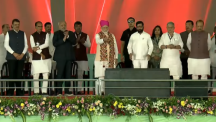Snapshot
Continuing an upward trend, agricultural exports rose to $53.1 Bn during the financial year 2022-23
Wheat exports touched $1519.69 Mn in FY 2022-23 and the grain's exports are likely to exceed 10 MT by the end of 2022-23.
The growth in the agriculture sector is likely to remain buoyant, supported by healthy progress in Rabi sowing, with the area sown being higher than the previous year. Other cereals’ exports increased from $764 Mn in Apr-Dec 2021 to $869 Mn in Apr-Dec 2022 and the export of milled products increased from $188 Mn in Apr-Dec 2021 to $255 Mn in Apr-Dec 2022 registering a growth of 35.71%.
Fiscal policy statements highlighted that the Indian agriculture sector is projected to grow by 3.5% in FY 2022-23. Apart from meeting domestic requirements, India has also rapidly emerged as a net exporter of agricultural products in recent years. With the agriculture exports touching $50.2 Bn in FY 2022-23. For 2023-24, production of Kharif Nutri/coarse cereals is estimated at 351.37 LMT.
As per Second Advance Estimates for 2023-24, Total Food grain production in the country is estimated at 3288.52 Lakh Tonnes Total production of Rice during 2023-24 is estimated at 1367 LMT. Production of Maize in the country during 2023-24 is estimated at 356.73 Lakh Tonnes.
The production of Moong is estimated at 14.05 LMT. Total Kharif pulses production during 2023-24 is estimated at 71.18 LMT. The production of Soybean & Groundnut is estimated at 130.54 LMT and 78.29 LMT respectively. Total Oilseeds production in the country during 2023-24 is estimated at 395.93 Lakh Tonnes.
The total production of Sugarcane in the country during 2023-24 is estimated at a record 4425.22 Lakh Tonnes.
Production of Cotton is estimated at 325.22 Lakh Bales (of 170 kg each) and production of Jute & Mesta is estimated at 92.59 Lakh Bales (of 180 kg each).
As per the Second Advance Estimates of 2023-24, the horticulture production in the country in 2023-24 is estimated to be about 352.23 Mn Tonnes.
- #
Milk production in the world contributing 24% of global milk production
- #
Producer of millet in the world with an area of 15.48 million hectares under cultivation.
- #
Producer of Sugar
- #
Number of organic farmers and has 59.1 Lakh ha area under organic farming
India is the largest producer of milk, coconuts, black tea, ginger, and turmeric; and the 2nd largest producer of cashew nuts, and tea in the world
India is the 2nd largest producer of fruits and vegetables, rice, wheat, groundnuts, cashew, and tea globally; and accounts for 10% of the world’s fruit production with first rank in the production of mango, bananas, sapota, and acid lime
The nation has a cold storage facility with a 374.25 Lakh MT capacity
- Industry Scenario
- FOREIGN INVESTMENT
- INDUSTRY TRENDS
- POLICIES & SCHEMES
Industry Scenario
According to the provisional data released by the Directorate General of Commercial Intelligence and Statistics (DGCI&S), the exports of agricultural and processed food products rose by 13% to $19.69 Bn in the nine months of the Financial Year 2022-23 (Apr-Dec) in comparison with the corresponding period of FY 2021-22.
In 2022-23, fresh fruits and vegetables were exported to the tune of $1635.95 Mn which comprised Fresh Fruits worth $770.70 Mn and vegetables worth $865.24 Mn. Exports of processed F&V jumped to $2,248.96 Mn in FY 2022-23.
Basmati Rice exports were 26.08 LMT for the period Apr-Oct'23. The export of non-Basmati rice were witnessed at 73.18 LMT for the period Apr-Oct'23. The export of pulses has been recorded at 3.41 LMT for the period Apr-Oct'23.
Organic Products:
India has the highest number of organic farmers in the world at 44.3 Lakhs, and 59.1 Lakh ha area has been brought under organic farming by 2021-22, producing certified organic products including all varieties of food products namely Oil Seeds, fiber, Sugar cane, Cereals & Millets, Cotton, Pulses, Aromatic & Medicinal Plants, Tea, Coffee, Fruits, Spices, Dry Fruits, Vegetables, Processed foods, etc. The production is not limited to the edible sector but also produces organic cotton fiber, functional food products, etc.
Union Budget 2023 Highlights:
- INR 20 Lakh Cr: Agricultural Credit Target with a focus on Animal Husbandry, dairy and fisheries sector.
- Aatmanirbhar Bharat Horticulture Clean Plant Program: Outlay of INR 2200 Cr to promote high-value horticulture crops.
- Agricultural Accelerator Fund: To be setup to promote startups in rural India.
- Provision of INR 60,000 Cr has been made for the Pradhan Mantri Kisan Samman Nidhi (PM-Kisan).
- Provision of INR 450 Cr has been made for the Digital Agriculture Mission started by the Modi Government, and about INR 600 Cr allocated for the promotion of Agriculture sector through technology.
- The government will launch a sub-scheme under PM Matsya Sampada Yojana with an outlay of INR 6,000 Cr.
GROWTH DRIVERS
Demand-side drivers
Population and income growth creates new opportunities for farmers and businesses to expand and innovate, encouraging the sector to adopt new technologies and practices and explore new markets both domestically and internationally.
Increasing exports
Increasing exports have opened up new markets and supply chains for Indian farmers and businesses. This has increased competitiveness in the sector and encouraged innovation and expansion.
Supply-side drivers
Hybrid and genetically modified seeds, ideal climate, technologically advanced irrigation infrastructure, the Green Revolution in Eastern India to address the constraints limiting the productivity of “rice based cropping systems” and an increase in climate-smart agricultural practices.
Policy support
Growing institutional credit, Increasing MSP, Introduction of new schemes like Paramparagat Krishi Vikas Yojana, Pradhanmantri Gram, Sinchai Yojana, and Sansad Adarsh Gram Yojana, Inception of Agri Infrastructure Fund, promotion of agricultural mechanization and subsidy for machines and supports drones.
Logistics support
Initiatives like Kisan Rath (mobile app for farmers, FPOs, and traders), 200+ Kisan Rails, and Krishi Udaan Scheme for produce transportation, Perishable Cargo Centres, cold storage facilities at Airports and Inland Container Depots as well as cargo terminals and warehouses.
Digital Transformation
e-NAM, spanning 1260 APMC mandis in 22 States and 3 UTs, enables online trading of 203 agricultural commodities, benefiting farmers with better remunerative prices for their produce. It catalyses the digital transformation of mandi operations and e-trading of agricultural commodities.
Changing Consumer Preferences
Consumers in India are increasingly looking for organic and locally sourced produce, creating opportunities for small-scale farmers to enter the market and differentiate their products from those of larger agricultural corporation
Krishi Nivesh
Development of the Agriculture Investment Portal named “Krishi Nivesh” to boost agriculture investment . The portal is an Integrated, centralized one-stop Portal for all Agri-investors to avail benefits from various Government schemes.
















